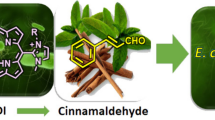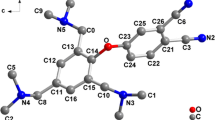Abstrat
Given that cell-penetrating peptides (CPP) are cationic and often amphipathic, similar to membrane-active antimicrobial peptides, it may be possible to use CPP conjugation to improve the delivery of photosensitisers for antimicrobial photodynamic therapy (antimicrobial PDT). We investigated the possibility of using a Tat peptide to deliver the photosensitiser, tetrakis(phenyl)porphyrin (TPP) and kill bacteria. The Tat peptide is a positively-charged mammalian cell-penetrating peptide with potent antimicrobial activity but no haemolytic activity. Fluorescence spectroscopy revealed that the bioconjugate can bind to and/or be incorporated into all bacterial species tested. All species were susceptible to the Tat-porphyrin, with the bactericidal effect being dependent on both the concentration and the light dose. Using the highest light dose, treatment with the Tat-porphyrin achieved reductions of 6.6 log10 and 6.37 log10 in the viable counts of Staphylococcus aureus and Streptococcus pyogenes, and reductions of 5.74 log10 and 6.6 log10 in the viable counts of Pseudomonas aeruginosa and Escherichia coli. Moreover, the Tat moiety appears to confer antimicrobial properties to the conjugate, particularly for the Gram positive strains, based on the observation of dark toxicity using 1 μM of Tat-porphyrin. Finally, the conjugate induced membrane destabilization by synergistic action of the peptide and PDT, resulting in carboxyfluorescein leakage from bacterial membrane-mimicking liposomes. These findings demonstrate that the use of CPP to deliver a photosensitiser is an effective way of improving the uptake and the treatment efficacy of antimicrobial PDT.
Similar content being viewed by others
References
M. R. Hamblin, T. Hasan, Photodynamic therapy: a new antimicrobial approach to infectious disease?, Photochem. Photobiol. Sci., 2004, 3, 436–450.
G. Jori, S. B. Brown, Photosensitized inactivation of microorganisms, Photochem. Photobiol. Sci., 2004, 3, 403–405.
T. Maisch, Antimicrobial photodynamic therapy: useful in the future?, Lasers Med. Sci., 2007, 22, 83–91.
T. Dai, Y. Y. Huang, M. R. Hamblin, Photodynamic therapy for localized infections–state of the art, Photodiagn. Photodyn. Ther., 2009, 6, 170–188.
N. Komerik, A. J. MacRobert, Photodynamic therapy as an alternative antimicrobial modality for oral infections, J. Environ. Pathol. Toxicol. Oncol., 2006, 25, 487–504.
M. Wilson, Bactericidal effect of laser light and its potential use in the treatment of plaque-related diseases, Int. Dent. J., 1994, 44, 181–189.
M. Wilson, Photolysis of oral bacteria and its potential use in the treatment of caries and periodontal disease, J. Appl. Bacteriol., 1993, 75, 299–306.
S. Choudhary, K. Nouri, M. L. Elsaie, Photodynamic therapy in dermatology: a review, Lasers Med. Sci., 2009, 24, 971–980.
M. Wainwright, Photodynamic antimicrobial chemotherapy (PACT), J. Antimicrob. Chemother., 1998, 42, 13–28.
P. S. Zolfaghari, S. Packer, M. Singer, S. P. Nair, J. Bennett, C. Street, M. Wilson, In vivo killing of Staphylococcus aureus using a light-activated antimicrobial agent, BMC Microbiol., 2009, 9, 27.
B. Zeina, J. Greenman, W. M. Purcell, B. Das, Killing of cutaneous microbial species by photodynamic therapy, Br. J. Dermatol., 2001, 144, 274–278.
P. A. Lambert, Cellular impermeability and uptake of biocides and antibiotics in gram-positive bacteria and mycobacteria, Symp. Ser. Soc. Appl. Microbiol., 2002 46S-54S.
S. P. Denyer, J. Y. Maillard, Cellular impermeability and uptake of biocides and antibiotics in Gram-negative bacteria, J. Appl. Microbiol., 2002, 92, s1 35S-45S.
L. Leive, The barrier function of the gram-negative envelope, Ann. N. Y. Acad. Sci., 1974, 235, 109–129.
R. E. Hancock, Alterations in outer membrane permeability, Annu. Rev. Microbiol., 1984, 38, 237–264.
Z. Malik, H. Ladan, Y. Nitzan, Photodynamic Inactivation of Gram-Negative Bacteria - Problems and Possible Solutions, J. Photochem. Photobiol., B, 1992, 14, 262–266.
G. Bertoloni, F. Rossi, G. Valduga, G. Jori, J. Vanlier, Photosensitizing Activity of Water-Soluble and Lipid-Soluble Phthalocyanines on Escherichia-Coli, FEMS Microbiol. Lett., 1990, 71, 149–155.
M. R. Hamblin, D. A. O’Donnell, N. Murthy, K. Rajagopalan, N. Michaud, M. E. Sherwood, T. Hasan, Polycationic photosensitizer conjugates: effects of chain length and Gram classification on the photodynamic inactivation of bacteria, J. Antimicrob. Chemother., 2002, 49, 941–951.
G. P. Tegos, M. Anbe, C. Yang, T. N. Demidova, M. Satti, P. Mroz, S. Janjua, F. Gad, M. R. Hamblin, Protease-stable polycationic photosensitizer conjugates between polyethyleneimine and chlorin(e6) for broad-spectrum antimicrobial photoinactivation, Antimicrob. Agents Chemother., 2006, 50, 1402–1410.
Y. Nitzan, M. Gutterman, Z. Malik, B. Ehrenberg, Inactivation of gram-negative bacteria by photosensitized porphyrins, Photochem. Photobiol., 1992, 55, 89–96.
R. Bonnett, D. G. Buckley, T. Burrow, A. B. B. Galia, B. Saville, S. P. Songca, Photobactericidal Materials Based on Porphyrins and Phthalocyanines, J. Mater. Chem., 1993, 3, 323–324.
T. A. Dahl, W. R. Midden, P. E. Hartman, Comparison of killing of gram-negative and gram-positive bacteria by pure singlet oxygen, J. Bacteriol., 1989, 171, 2188–2194.
C. Perria, M. Carai, A. Falzoi, G. Orunesu, A. Rocca, G. Massarelli, N. Francaviglia, G. Jori, Photodynamic therapy of malignant brain tumors: clinical results of, difficulties with, questions about, and future prospects for the neurosurgical applications, Neurosurgery, 1988, 23, 557–563.
B. Ehrenberg, Z. Malik, Y. Nitzan, H. Ladan, F. M. Johnson, G. Hemmi, J. L. Sessler, The Binding and Photosensitization Effects of Tetrabenzoporphyrins and Texaphyrin in Bacterial-Cells, Lasers Med. Sci., 1993, 8, 197–203.
G. Bertoloni, F. Rossi, G. Valduga, G. Jori, H. Ali, J. E. van Lier, Photosensitizing activity of water- and lipid-soluble phthalocyanines on prokaryotic and eukaryotic microbial cells, Microbios, 1992, 71, 33–46.
D. A. Caminos, M. B. Spesia, P. Pons, E. N. Durantini, Mechanisms of Escherichia coli photodynamic inactivation by an amphiphilic tricationic porphyrin and 5,10,15,20-tetra(4-N,N,N-trimethylammoniumphenyl) porphyrin, Photochem. Photobiol. Sci., 2008, 7, 1071–1078.
M. Lindgren, M. Hallbrink, A. Prochiantz, U. Langel, Cell-penetrating peptides, Trends Pharmacol. Sci., 2000, 21, 99–103.
C. Palm, S. Netzereab, M. Hallbrink, Quantitatively determined uptake of cell-penetrating peptides in non-mammalian cells with an evaluation of degradation and antimicrobial effects, Peptides, 2006, 27, 1710–1716.
R. E. Hancock, G. Diamond, The role of cationic antimicrobial peptides in innate host defences, Trends Microbiol., 2000, 8, 402–410.
R. I. Lehrer, T. Ganz, Antimicrobial peptides in mammalian and insect host defence, Curr. Opin. Immunol., 1999, 11, 23–27.
M. Zasloff, Antimicrobial peptides of multicellular organisms, Nature, 2002, 415, 389–395.
N. Nekhotiaeva, A. Elmquist, G. K. Rajarao, M. Hallbrink, U. Langel, L. Good, Cell entry and antimicrobial properties of eukaryotic cell-penetrating peptides, FASEB J, 2004, 18, 394–396.
H. G. Boman, B. Agerberth, A. Boman, Mechanisms of Action on Escherichia-Coli of Cecropin-P1 and Pr-39, 2 Antibacterial Peptides from Pig Intestine, Infection and Immunity, 1993, 61, 2978–2984.
K. Sadler, K. D. Eom, J. L. Yang, Y. Dimitrova, J. P. Tam, Translocating proline-rich peptides from the antimicrobial peptide bactenecin 7, Biochemistry, 2002, 41, 14150–14157.
B. Skerlavaj, D. Romeo, R. Gennaro, Rapid Membrane Permeabilization and Inhibition of Vital Functions of Gram-Negative Bacteria by Bactenecins, Infection and Immunity, 1990, 58, 3724–3730.
G. Tunnemann, R. M. Martin, S. Haupt, C. Patsch, F. Edenhofer, M. C. Cardoso, Cargo-dependent mode of uptake and bioavailability of TAT-containing proteins and peptides in living cells, FASEB J., 2006, 20, 1775–1784.
M. Zhao, R. Weissleder, Intracellular cargo delivery using tat peptide and derivatives, Med. Res. Rev., 2004, 24, 1–12.
H. J. Jung, K. S. Jeong, D. G. Lee, Effective antibacterial action of Tat (47-58) by increased uptake into bacterial cells in the presence of trypsin, J. Microbiol. Biotechnol., 2008, 18, 990–996.
H. J. Jung, Y. Park, K. S. Hahm, D. G. Lee, Biological activity of Tat (47-58) peptide on human pathogenic fungi, Biochem. Biophys. Res. Commun., 2006, 345, 222–228.
M. Sibrian-Vazquez, J. Ortiz, I. V. Nesterova, F. Fernandez-Lazaro, A. Sastre-Santos, S. A. Soper, M. G. Vicente, Synthesis and properties of cell-targeted Zn(II)-phthalocyanine-peptide conjugates, Bioconjugate Chem., 2007, 18, 410–420.
C. Tanielian, C. Wolff, Porphyrin-Sensitized Generation of Singlet Molecular Oxygen: Comparison of Steady-State and Time-Resolved Methods, J. Phys. Chem., 1995, 99, 9825–9830.
R. F. Chen, J. R. Knutson, Mechanism of fluorescence concentration quenching of carboxyfluorescein in liposomes: energy transfer to nonfluorescent dimers, Anal. Biochem., 1988, 172, 61–77.
H. Mojzisova, S. Bonneau, P. Maillard, K. Berg, D. Brault, Photosensitizing properties of chlorins in solution and in membrane-mimicking systems, Photochem. Photobiol. Sci., 2009, 8, 778–787.
J. P. Gratton, J. Yu, J. W. Griffith, R. W. Babbitt, R. S. Scotland, R. Hickey, F. J. Giordano, W. C. Sessa, Cell-permeable peptides improve cellular uptake and therapeutic gene delivery of replication-deficient viruses in cells and in vivo, Nat. Med., 2003, 9, 357–362.
H. Xia, Q. Mao, B. L. Davidson, The HIV Tat protein transduction domain improves the biodistribution of beta-glucuronidase expressed from recombinant viral vectors, Nat. Biotechnol., 2001, 19, 640–644.
D. Derossi, A. H. Joliot, G. Chassaing, A. Prochiantz, The third helix of the Antennapedia homeodomain translocates through biological membranes, J. Biol. Chem, 1994, 269, 10444–10450.
I. M. Kaplan, J. S. Wadia, S. F. Dowdy, Cationic TAT peptide transduction domain enters cells by macropinocytosis, J. Controlled Release, 2005, 102, 247–253.
C. Subbalakshmi, N. Sitaram, Mechanism of antimicrobial action of indolicidin, FEMS Microbiol. Lett., 1998, 160, 91–96.
H. Sugiarto, P. L. Yu, Mechanisms of action of ostrich beta-defensins against Escherichia coli, FEMS Microbiol. Lett., 2007, 270, 195–200.
W. S. Sung, I. S. Lee, D. G. Lee, Damage to the cytoplasmic membrane and cell death caused by lycopene in Candida albicans, J. Microbiol. Biotechnol., 2007, 17, 1797–1804.
M. Dathe, J. Meyer, M. Beyermann, B. Maul, C. Hoischen, M. Bienert, General aspects of peptide selectivity towards lipid bilayers and cell membranes studied by variation of the structural parameters of amphipathic helical model peptides, Biochim. Biophys. Acta, Biomembr., 2002, 1558, 171–186.
A. Pokorny, T. H. Birkbeck, P. F. Almeida, Mechanism and kinetics of delta-lysin interaction with phospholipid vesicles, Biochemistry, 2002, 41, 11044–11056.
W. T. Heller, A. J. Waring, R. I. Lehrer, T. A. Harroun, T. M. Weiss, L. Yang, H. W. Huang, Membrane thinning effect of the beta-sheet antimicrobial protegrin, Biochemistry, 2000, 39, 139–145.
F. M. Marassi, S. J. Opella, P. Juvvadi, R. B. Merrifield, Orientation of cecropin A helices in phospholipid bilayers determined by solid-state NMR spectroscopy, Biophys. J., 1999, 77, 3152–3155.
K. Matsuzaki, Magainins as paradigm for the mode of action of pore forming polypeptides, Biochim. Biophys. Acta, 1998, 1376, 391–400.
G. Jori, Photodynamic therapy of microbial infections: State of the art and perspectives, Journal of Environmental Pathology Toxicology and Oncology, 2006, 25, 505–519.
W. L. Zhu, S. Y. Shin, Effects of dimerization of the cell-penetrating peptide Tat analog on antimicrobial activity and mechanism of bactericidal action, J. Pept. Sci., 2009, 15, 345–352.
L. Huang, M. Terakawa, T. Zhiyentayev, Y. Y. Huang, Y. Sawayama, A. Jahnke, G. P. Tegos, T. Wharton, M. R. Hamblin, Innovative cationic fullerenes as broad-spectrum light-activated antimicrobials, Nanomed.: Nanotechnol., Biol. Med., 2010, 6, 442–452.
F. Pereira, Gonzales, T. Maisch, XF drugs: A new family of antibacterials, Drug News Perspect., 2010, 23, 167–174.
Author information
Authors and Affiliations
Corresponding author
Rights and permissions
About this article
Cite this article
Bourré, L., Giuntini, F., Eggleston, I.M. et al. Effective photoinactivation of Gram-positive and Gram-negative bacterial strains using an HIV-1 Tat peptide—porphyrin conjugate. Photochem Photobiol Sci 9, 1613–1620 (2010). https://doi.org/10.1039/c0pp00146e
Received:
Accepted:
Published:
Issue Date:
DOI: https://doi.org/10.1039/c0pp00146e




